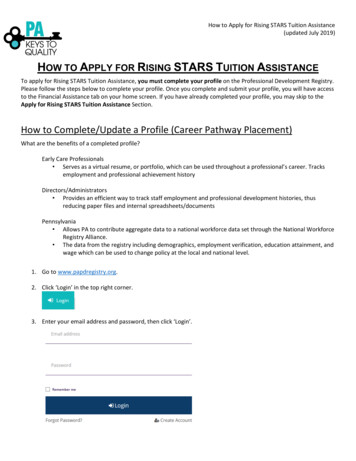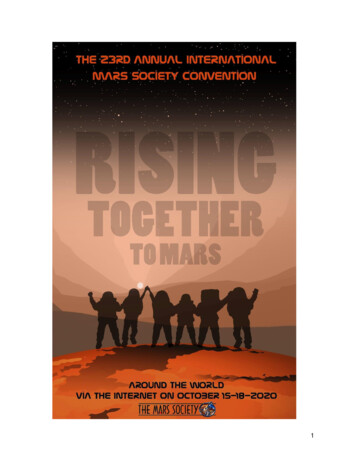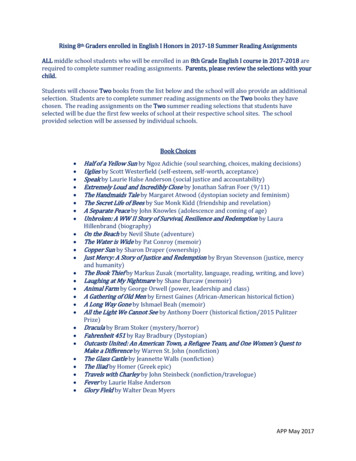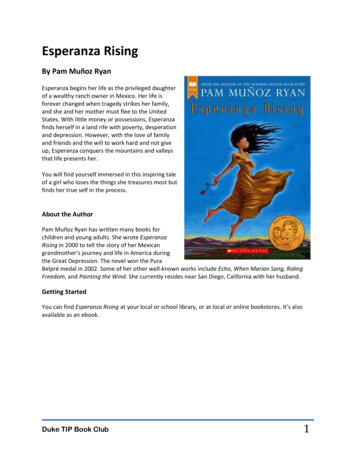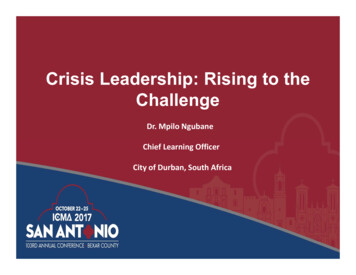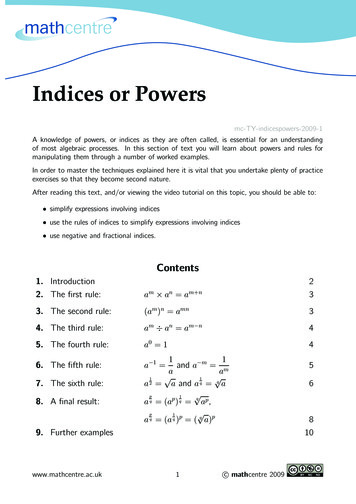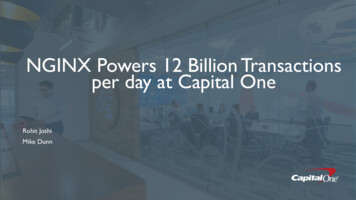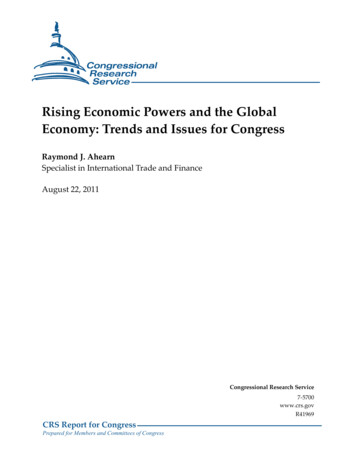
Transcription
Rising Economic Powers and the GlobalEconomy: Trends and Issues for CongressRaymond J. AhearnSpecialist in International Trade and FinanceAugust 22, 2011Congressional Research Service7-5700www.crs.govR41969CRS Report for CongressPrepared for Members and Committees of Congress
Rising Economic Powers and the Global Economy: Trends and Issues for CongressSummaryA small group of developing countries are transforming the global economic landscape. Led byChina, India, and Brazil, these rising economic powers pose varied challenges and opportunitiesfor U.S. economic interests and leadership of the global economy. They also raise significantpolicy issues for Congress, including the future direction of U.S. trade policy and negotiations, aswell as for the multilateral economic institutions that have historically served as the foundation ofan open and rules-based global economy.This report addresses ongoing shifts in global trade and finance and projected future trendsresulting from the emergence of these economies. It is the first of a three-part CRS series thatfocuses on how the Rising Economic Powers are affecting U.S. interests and raising challengesfor congressional oversight of U.S. international trade and financial policies.The major trends in the global economy identified and discussed in this report are: The balance of global economic power is shifting from the United States andEurope to a number of fast-growing and large developing countries. Theseeconomies account for rising shares of global GDP, manufacturing, and trade,including a significant expansion of trade among the developing countries(South-South trade). These shifts are driven by growing economic integration andinterdependence among economies, particularly through new global productionand supply chains that incorporate inputs from many different countries. Rising economic powers are becoming more important players in internationalfinance. They have increased holdings of foreign exchange reserves, establishedsovereign wealth funds, borrowed capital from international capital markets, andattracted substantial foreign investment. Their multinational corporations, manystate-owned, are investing assets globally and are competing with U.S. firms fornatural resources and access to other developing-country markets. The long-standing distinction between advanced and developing countries,particularly for rising economic powers, is blurring. The advanced countries maystill be the richest countries in terms of per capita income, but their economiesmay no longer be the largest, the fastest-growing, or the most dynamic. Risingeconomic powers are exerting greater influence in global trade and financialpolicies and in the multilateral institutions that have underpinned the globaleconomy since World War II. These developments, in turn, have implications forU.S. global leadership that are subject to debate. While the impact of the rising economic powers is considered by mosteconomists to be strongly positive for the U.S. economy overall, not all groups ofAmericans have benefitted equally. Highly educated workers are seen gainingmore job opportunities and higher wages than workers with less education.Issues for Congress on the international trade and finance policies raised by the changing globallandscape could include: Seizing full advantage of growing markets for U.S. manufacturers, serviceproviders, agricultural producers, and their workers, including preparing forincreased competition.Congressional Research Service
Rising Economic Powers and the Global Economy: Trends and Issues for Congress The future direction of U.S. trade negotiations and the global trading system, aswell as specific policies and issues raised by the global economy. These mightinclude the increasing role of state-owned enterprises, access to developingcountry markets for services and government procurement, the future role of thedollar as the primary reserve currency, and U.S. participation in global supplychains, among other issues. The evolution of international frameworks for financial integration, as well asmultilateral and bilateral frameworks for foreign direct investment and sovereignwealth funds.This report will be updated as events warrant.Congressional Research Service
Rising Economic Powers and the Global Economy: Trends and Issues for CongressContentsIntroduction. 1The Changing Global Economic Landscape. 2Shifts in Global Production and Trade . 3World GDP Rankings . 3Sources of World Growth. 7Location of Global Manufacturing and Services . 9New Patterns of International Trade Flows. 13International Finance . 18Rising Wealth . 18Capital Flows . 20Emerging Market Multinational Corporations . 22Issues for Congress . 25International Trade. 26Growing Markets for U.S. Exporters and Investors. 26Preparing for Increased Competition . 27U.S. Trade Negotiations and New Trade Policy Challenges . 28Reconsidering Traditional Statistics of International Trade . 30International Finance . 31Strengthening International Frameworks for Financial Integration . 31Rules for Foreign Direct Investment . 32Operation of Sovereign Wealth Funds and State-Owned Multinationals. 34Future of the Dollar as the Primary Reserve Currency . 35Functioning of the Global Economy . 37Reform of the Bretton Woods Institutions. 37Role of the G-20. 38Outlook . 38FiguresFigure 1. World GDP Distribution by Economic Grouping, 1960-2009 . 4Figure 2. Share of the Global Economy for OECD and Non-OECD Countries, 1990 2030 . 4Figure 3. World GDP Distribution by Country, 1960-2009. 5Figure 4. U.S. and China GDP, 2009 and 2050 . 6Figure 5. Contribution to Global Growth, by Group and Region, 1973-2009. 8Figure 6. The Globalization of Production: The Example of the Boeing 787 Dreamliner. 12Figure 7. Exports by Region, 1990 and 2008 . 14Figure 8. Regional Shares in World Exports of Intermediate Goods, 1995 and 2009 . 16Figure 9. iPod-Related Earnings and Jobs, Country and Category 2006. 18Figure 10. Global FDI Inflows, 1970-2008 . 21Congressional Research Service
Rising Economic Powers and the Global Economy: Trends and Issues for CongressFigure 11. Cross-Border Patents Granted Worldwide to Residents ofEmerging Economies, 1995-2008. 24Figure 12. Total Number of Active Bilateral Investment Treaties, 1980-2007. 32Figure 13. Distribution of Bilateral Investment Treaties (BITs), 2008. 33Figure 14. Number of Bilateral Investment Treaties Signed by Advanced Countries, as of2007 . 34TablesTable 1. Share of the BRIC Bloc in the World Economy . 5Table 2. Changes in Composition of Output by Group and Sector, 1960-2008 . 9Table 3. Growth of Output by Group, Region, and Sector,1973-2008 . 10Table 4. Manufacturing Value Added Per Capita, 1990-2007 . 11Table 5. Composition of Exports by Group, 1960-2007. 15Table 6. Major Developing Country Holders of U.S. Treasury Securities . 19ContactsAuthor Contact Information. 39Acknowledgments . 40Congressional Research Service
Rising Economic Powers and the Global Economy: Trends and Issues for CongressIntroductionThe global economy has undergone dramatic changes over the past 60 years. In the early 1950s,the world economy was essentially divided between developed or industrialized countries in the“North” and developing or non-industrialized countries in the “South.” Developed countries,excluding Japan, at that time accounted for 90% of world manufacturing output and 90% of worldexports of manufactured goods. Production remained largely enclosed within national boundariesand trade patterns reflected the respective country specializations. Inputs for most products weresourced within national borders. In addition to a large imbalance in the structure of productionand exports, there was a dramatic imbalance in living standards and political power as well.1From the 1950s to the mid-1990s, these imbalances began to reverse gradually. By 1995, forexample, the advanced countries’ share of manufacturing output had fallen to 80%. But thenarrowing of the great 20th century divide between advanced and developing countriesaccelerated rapidly over the past two decades with traditional production, trade, and financepatterns being replaced by new and more balanced configurations.Spurred by the information technology (IT) revolution, trade liberalization and other economicreforms, the entry of an estimated 2 billion people into the labor force as a result of thebreakdown of the Soviet bloc and the opening of China, and the freer movement of capital andtechnology from developed countries to developing countries, the size of the global economydoubled over the decade preceding the 2008-2009 global financial crisis, increasing from 31trillion in 1999 to 62 trillion in 2008. While the growth reached practically every region of theworld and encompassed dozens of developing countries, a handful of large developingcountries—led by China, India, and Brazil—accounted for a major share of the global growth.Other emerging economies with large populations, such as Indonesia, Mexico, Russia, Turkey,and Vietnam, also grew at a rapid pace. This faster growth has enabled developing countries toexpand their share of global GDP, rising from around one-fifth of global GDP in 2000 to morethan one-third of world output today, fueling speculation that the world’s economic balance ofpower is rapidly shifting away from the United States and Europe toward rising powers in Asiaand Latin America.2In addition to altering global GDP rankings, the changes in the global economy have affected thecenters of economic growth, the location of manufacturing, and international trade patterns.Buttressed by their exporting success and rising incomes, developing countries are also becomingmore important players in the international financial system. If current trends persist, the shifts inwealth and power could become more pronounced over the next several decades.With important responsibilities for the formulation of U.S. international trade and financialpolicies, Congress has an interest in understanding how these shifts of wealth and power areaffecting U.S. economic interests. This report addresses these concerns in two parts by (1)describing and analyzing trends that are transforming the global economy, and (2) highlightingvaried policy challenges raised by the new global economy for congressional consideration.1Ronald Findlay and Kevin
CRS Report for Congress Prepared for Members and Committees of Congress Rising Economic Powers and the Global Economy: Trends and Issues for Congress Raymond J. Ahearn Specialist in International Trade and Finance August 22, 2011 Congressional Research Service 7-5700 www.crs.gov R41969 . Rising Economic Powers and the Global Economy: Trends and Issues for Congress



